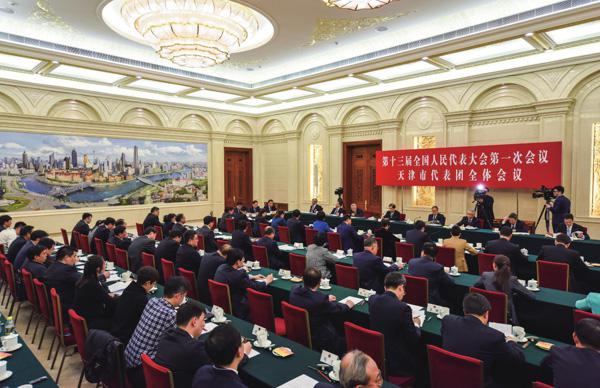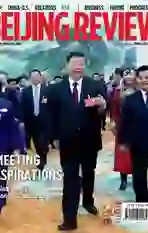An Integrated Fast Track
2018-04-08ByYuanYuan
By Yuan Yuan

Guo Jianying, a National Peoples Congress (NPC) deputy and Mayor of Baoding in Hebei Province, bought a bus pass before arriving in Beijing for the First Session of the 13th NPC.
This bus pass is an example of the integration efforts taking place within the areas of Beijing Municipality, Tianjin Municipality and Hebei Province, or as they are known collectively the Beijing-Tianjin-Hebei region. Issued in late 2015, the pass was initially restricted on certain lines within these three areas, but since December 30, 2017, it has given passengers access to almost all bus and subway lines in the Beijing-Tianjin-Hebei region. In Tianjin alone, 12,293 cards had been sold by February 26.
“The coordinated development of Beijing, Tianjin and Hebei has brought positive and profound changes to Baoding,” Guo said during a panel discussion of this years NPC on March 6 with deputies from Hebei.“The sky is getting bluer, transportation is getting more convenient and we are getting more investments from different channels.”
The Xiongan New Area located near Baoding, aiming to help spare Beijing of functions unrelated to its status as the national capital, has given a strong boost to the development of the city, as Guo said.
Connecting the dots
On March 1, the express rail connecting the Xiongan New Area in Hebei to Beijing started construction and is set to be in operation by the end of 2020. The 92.4-km railway, with a total investment of 33.53 billion yuan ($5.3 billion), will shorten the time from Xiongan to Beijing to 30 minutes, a distance of about 195 km. The time from Xiongan to the Beijing New Airport, which is under construction, will be cut to only 20 minutes.
“This will be a powerful engine for increasing the integration of development of Beijing, Tianjin and Hebei,” Wang Dongfeng, an NPC deputy and Secretary of the Communist Party of China (CPC) Hebei Provincial Committee, said during the panel discussion. “We are looking to create a onehour transportation network in the three areas.”
Also on March 1, senior offi cials from the Beijing Municipal Commission of Education and the administration of the Xiongan New Area unveiled nameplates for four new schools in Xiongan.
Beijing will build a kindergarten, two primary schools and a middle school as part of its first educational project in Xiongan. These schools, such as Zhongguancun No.3 Primary School and Chaoyang Experimental Primary School, are key schools in the capital. Beijing will secure 10 million yuan ($1.58 million) in a specific fund for this project each year.
According to an agreement signed on March 1, both parties will work together to construct key schools, train teachers and improve overall teaching quality. Beijing has agreed to send senior teachers and manage- ment groups to Xiongan to support the initial running of the schools.
Moreover, Beijing will organize a series of training courses in 2018 for teachers and offi cials from the educational department in Xiongan.
In addition, more than 10 agreements on education cooperation and exchange have been signed among Beijing, Tianjin and Hebei, while eight university unions from the three regions have been organized to promote cooperation on academic research and scientifi c and technological innovation.
“Beijing and Tianjin have better and more colleges than Hebei,” Du Yanliang, an NPC deputy, a professor at Shijiazhuang Tiedao University in Hebei and an academician at the Chinese Academy of Engineering, said during the panel discussion. “The exchange between professors and students is very necessary to optimize resources. I hope more efforts will be focused on this.”
As an expert on transportation planning, Du said optimization should also be applied to organizing these projects. “Now, rail and road are planned by separate departments, which can cause possible construction waste,” Du said. “As we expand the area covered by the express railways, we should also place importance on shortening commute times for passengers traveling to the railway stations, especially for people living in remote and rural areas.”
Cai Hua, an NPC deputy and a lawyer from Tianjin Shengli Law Firm, raised another transportation concern. “Cars from other areas in China, including Tianjin and Hebei, have to register to enter Beijing and are restricted to driving in Beijings central areas during peak hours, which has caused much inconvenience for the transportation integration,” Cai said. “I hope such restrictions can be discarded in the future as we fi nd other ways of dealing with traffi c congestion.”
Making it blue and green
Zhou Wentao, a technician from HBIS Group Co. Ltd., one of Chinas largest iron and steel material manufacturers and comprehensive service suppliers, told Beijing Review that it reduced production in winter 2017 to secure a “blue sky” in the BeijingTianjin-Hebei region. But as the company switched to new technologies in steel processing, the workers incomes were not deeply affected.
“Our company has been investing heavily in upgrading our facilities to meet the national standards for environmental protection,” Zhou said. “Now we are shifting from high-speed to high-quality development and our factory is as beautiful as a garden,” he stated.
Chinas Ministry of Environmental Protection recently released the figures on the average annual density of PM2.5 particles in the air in the Beijing-Tianjin-Hebei region, showing it has been reduced by 39.6 percent compared to 2013.
Wang Honghai, Secretary of Ninghe District Committee of the CPC in Tianjin, said that ecological restoration is one of the key tasks for the integrated development of the three areas.
For example, the Qilihai Wetland is a key ecological restoration project in Tianjin. In 2017, the Tianjin Municipal Government issued a plan aimed at restoring the wetland by 2025. “We will combine wetland construction with high-quality development and activated resources of all kinds to promote this project,” the government plan said.
It has been four years since the coordinated development of the Beijing-TianjinHebei region kicked off. Data from the National Bureau of Statistics shows that gaps among the three areas decreased in 2017 and their integration progressed.
Last year, the per-capita residential disposable income for Beijing was 57,230 yuan ($9,044); Tianjins was 37,022 yuan($5,850); while Hebeis was 21,484 yuan($3,395), up 6.9 percent, 6.5 percent and 7.1 percent, respectively year on year.
“The coordinated development of the three areas is one of the key tasks of our country,” Zhang Guoqing, an NPC deputy and Mayor of Tianjin, said on March 6. “We should provide solid benefits to the people and let everyone enjoy the fruits of regional coordination.”
